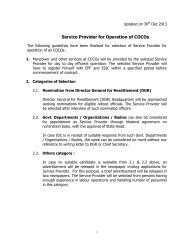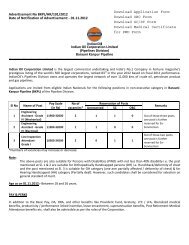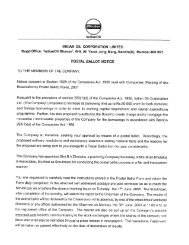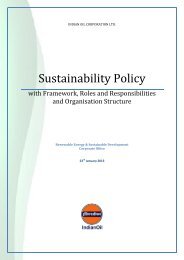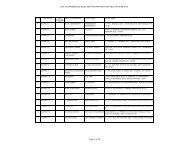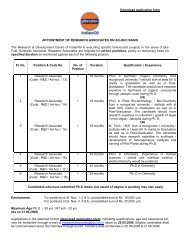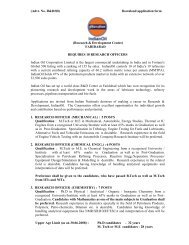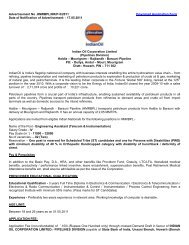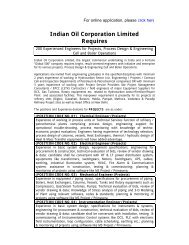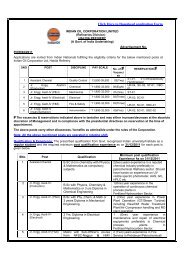Product Responsibility - Indian Oil Corporation Limited
Product Responsibility - Indian Oil Corporation Limited
Product Responsibility - Indian Oil Corporation Limited
You also want an ePaper? Increase the reach of your titles
YUMPU automatically turns print PDFs into web optimized ePapers that Google loves.
P r o d u c t<br />
R e s p o n s i b i l i t y
Sustainability<br />
Report<br />
2008-09<br />
<strong>Product</strong> <strong>Responsibility</strong> Strategy<br />
& Management Approach<br />
78<br />
Consistent product quality and a continuous<br />
upgradation of product profile is vital for <strong>Indian</strong><strong>Oil</strong>'s<br />
strategy. As a part of this endeavour, the <strong>Corporation</strong><br />
has undertaken product quality improvement projects<br />
at the refineries investing several thousand crores of<br />
rupees. Our R&D efforts are also aimed at improving the<br />
quality of our product offerings and reducing their<br />
environmental impact for the overall benefit of the<br />
world’s fragile eco-system.<br />
<strong>Indian</strong><strong>Oil</strong> is committed to the safe manufacture,<br />
distribution and handling of its products. The process<br />
of production of petroleum products is benchmarked to<br />
global standards and best utilizes given resources and at<br />
the same time ensures the safety of people and<br />
environment by actively identifying potential risk<br />
factors.<br />
Quality Management System<br />
As per the guidelines of the Ministry of Petroleum and<br />
Natural Gas, Government of India, the <strong>Oil</strong> Industry has<br />
evolved a uniform Quality Control procedure for<br />
handling of petroleum products. The Industry quality<br />
control manual covers the entire spectrum of supply<br />
and distribution of petroleum products. The procedures<br />
outlined in the manual are a basic requirement in order<br />
to ensure product quality of the petroleum products.<br />
Therefore, standard operating procedures with regard<br />
to safety in handling of petroleum products in general<br />
have to be followed as laid down in the respective Safety<br />
and Operations Manuals and also as enumerated in the<br />
Industry Manual on Acceptance of <strong>Product</strong> by<br />
Marketing Companies and Related Issues. <strong>Indian</strong><strong>Oil</strong> has<br />
developed a robust system to monitor such standard<br />
procedures which are followed at all times at its<br />
refinery, pipelines and marketing installations.<br />
Refineries<br />
All <strong>Indian</strong><strong>Oil</strong> refineries have ISO 9001:2000 systems<br />
certifications, which ensures that the right kind of<br />
product quality processes are adopted and the<br />
operations and product batches are further certified to<br />
meeting the stringent industry quality norms at the<br />
marketing locations for further despatches to the<br />
market.
Sustainability<br />
Report<br />
2008-09<br />
Marketing locations<br />
Utmost care is taken to ensure that petroleum products,<br />
whether indigenously produced at local refineries or<br />
imported, are received in accordance with the<br />
respective specifications and that they enter the<br />
marketing & distribution system in a condition that<br />
meets the stringent stipulations laid down in <strong>Indian</strong><strong>Oil</strong>’s<br />
operations philosophy guided by its quality control<br />
manual.<br />
A detailed system of quality control checks and<br />
documentation exists to ensure that adequate care is<br />
taken to maintain product quality at every step of the<br />
supply chain. In all the above activities, effective<br />
laboratory support is vital and hence these lab facilities<br />
are continuously upgraded with respect to the testing<br />
methodology and their capability to efficiently test the<br />
requisite number of samples submitted by user<br />
departments.<br />
Research and Development<br />
<strong>Indian</strong><strong>Oil</strong>’s R&D Centre is a state-of-the-art hub focused<br />
on cutting edge research in the field of energy and allied<br />
areas. It has contributed to several pioneering results in<br />
lubricants formulation, refining processes, pipeline<br />
transportation models, bio-fuels and fuel-efficient<br />
appliances. It has, for over three decades now,<br />
developed over 2,200 lubrication and grease<br />
formulations, meeting the varied needs of diverse<br />
sectors in the <strong>Indian</strong> industry. With 17 patents filed<br />
during 2008-09, the total number of active patents of<br />
<strong>Indian</strong><strong>Oil</strong> has gone upto 214(including 113 international<br />
patents).<br />
Customer Feedback<br />
The Customer Satisfaction Index is<br />
the most crucial performance<br />
indicator for <strong>Indian</strong><strong>Oil</strong> and as India’s<br />
flagship corporate, the mandate for<br />
the Company, which is also a part of<br />
our MoU commitment to the<br />
Government of India, is to strive<br />
continuously to maintain the highest<br />
score for customer satisfaction.<br />
79
Sustainability<br />
Report<br />
2008-09<br />
80<br />
A comprehensive customer feedback system - a robust resource in the quest<br />
for service excellence
Sustainability<br />
Report<br />
2008-09<br />
Customer Satisfaction Surveys<br />
Annually, <strong>Indian</strong><strong>Oil</strong> conducts an all-India Customer<br />
Satisfaction Survey that covers the areas of quality,<br />
value, timeliness, efficiency, ease of access,<br />
environment, response, frontline service behavior,<br />
commitment to customer, innovation etc. The results of<br />
the survey is utilized to fine-tune customer offerings in<br />
the future with an emphasis on continuous<br />
improvement and for further enhancing the organic<br />
customer feedback architecture.<br />
Other Initiatives<br />
Besides the above, <strong>Indian</strong><strong>Oil</strong> has initiated a number of<br />
steps across different market segments:<br />
• Enhancing the marketing network covering remote<br />
and distant locations and reaching the nooks and<br />
corners of the vast sub-continent.<br />
• Continuing to strengthen the Quality & Quantity<br />
(Q&Q) proposition by leveraging the benefits of<br />
technology through Retail Automation.<br />
• Improvement of sales force efficiency and<br />
effectiveness through skills updation<br />
• Establishing emergency service cells for LPG<br />
customers<br />
• Promoting higher service standards in LPG retailing<br />
network by recognising ‘Star Distributors’ in different<br />
markets<br />
• Providing customised product-service solutions to<br />
domestic and international airlines<br />
• Establishing <strong>Indian</strong><strong>Oil</strong> as a distinct brand with diverse<br />
product portfolios in the market place<br />
• To enhance customer service <strong>Indian</strong><strong>Oil</strong> has<br />
introduced SMS based booking of LPG refills<br />
Marketing Communication<br />
All marketing communications from <strong>Indian</strong><strong>Oil</strong> are<br />
designed to inform a diverse cross section of customer<br />
segments. Periodic media campaigns provide a window<br />
to <strong>Indian</strong><strong>Oil</strong>’s products and services portfolio range and<br />
are targeted at capturing both mindshare and market<br />
share in an increasingly competitive market. Such<br />
initiatives like the selection of dealers & distributors,<br />
details of customer service cell and emergency service<br />
cells operating in different areas, branding of products<br />
and services, legal matters, stakeholder communiqués<br />
and statutory notices play an important role in<br />
strengthening the close connect that <strong>Indian</strong><strong>Oil</strong> has with<br />
all its stakeholders.<br />
Recognitions<br />
• <strong>Indian</strong><strong>Oil</strong>, the only petroleum Company among 100<br />
other industrial giants to emerge as 'The Most<br />
Trusted Fuel Pump Brand' in ET's Brand Equity annual<br />
survey for the year 2008. Among the 'Top 50 Service<br />
Brands' of the country, it bagged the 7th position.<br />
• <strong>Indian</strong><strong>Oil</strong> received the '<strong>Oil</strong> & Gas Supply Chain<br />
Excellence' award at the Second Express, Logistics &<br />
Supply Chain Conclave (Asia-Pacific) organised by<br />
Indiatimes Mindscape along with Business India<br />
group.<br />
• In recognition of its Kisan Seva Kendra initiatives in<br />
the rural markets, <strong>Indian</strong><strong>Oil</strong> received the prestigious<br />
'Most Admired Retailer of the Year - Rural Retailing'<br />
award at the India Retail Forum.<br />
81
Sustainability<br />
Report<br />
2008-09<br />
Kisan Seva Kendra - Taking Energy to the Heartland<br />
• <strong>Indian</strong><strong>Oil</strong> has been conferred the 'Business<br />
Superbrand 2008' status by the Superbrands<br />
Council of India.<br />
• <strong>Indian</strong><strong>Oil</strong> has been ranked no. 1 in the ET500 rankings<br />
as well as the BW500 rankings and figures in the top<br />
five in the Business India's Super 100<br />
• <strong>Indian</strong><strong>Oil</strong> leads India Inc in Fortune Global 500<br />
th<br />
listing for 2009-105 position<br />
Reaching a golden<br />
milestone...<br />
• <strong>Indian</strong><strong>Oil</strong> is the only PSU among India’s 25 best<br />
employers<br />
• <strong>Indian</strong><strong>Oil</strong> is frontrunner in the <strong>Oil</strong> and Gas category in<br />
the FE 500 listing of India’s top corporates<br />
84<br />
• <strong>Indian</strong><strong>Oil</strong> is No.1 in Business Standard’s ‘BS 1000’<br />
list
Innovations with a focus on R&D
Sustainability<br />
Report<br />
2008-09<br />
The journey for revisiting<br />
the Vision<br />
was designed to<br />
capture the<br />
collective<br />
aspirations of<br />
<strong>Indian</strong><strong>Oil</strong>People<br />
and also all its<br />
stake-holders, so<br />
that it becomes a<br />
'Shared Vision'<br />
rather than 'Vision<br />
Shared'.<br />
86<br />
Epilogue<br />
The fourth edition of <strong>Indian</strong><strong>Oil</strong>'s Sustainability Report is<br />
special. The edition is brought out against the backdrop of<br />
the <strong>Corporation</strong>'s Golden Jubilee Celebrations<br />
(1959-2009). It is even more special since this year (2009),<br />
<strong>Indian</strong><strong>Oil</strong> unveiled its recreated vision statement that is a<br />
consolidation of its past 50 years of achievement and<br />
experience, accommodating the <strong>Corporation</strong>'s aspirations<br />
and ambitions for the future. The new Vision is a matrix<br />
with identified elements of Vision; People, Innovation,<br />
Environment, Technology, Customers and Ethics.<br />
The Vision is a beacon for <strong>Indian</strong><strong>Oil</strong>'s continuous<br />
journey to explore new & responsible business<br />
processes to ensure a growth path that is sustainable for<br />
People, Planet and Profit.<br />
CSR is increasingly recognised as key to sustainable<br />
commercial success. <strong>Indian</strong><strong>Oil</strong> too has been very<br />
sensitive to broader CSR issues impacting M&A<br />
transactions. The 360 degrees measure employed by<br />
<strong>Indian</strong><strong>Oil</strong> ensured a seamless and smooth integration of<br />
Bongaigaon Refineries & Petrochemical Ltd with<br />
<strong>Indian</strong><strong>Oil</strong>, as its 8th<br />
Refinery and has<br />
b e e n a m a j o r<br />
accomplishment in<br />
our Golden Jubilee<br />
year. The merger has<br />
brought in synergy in<br />
i n f r a s t r u c t u r e<br />
facilities, safety,<br />
s o c i a l a n d<br />
environmental factors along with optimization of<br />
operating costs and human resources deployment.<br />
It gives us a great deal of satisfaction to accommodate<br />
the several constructive suggestions that we have<br />
received from many of our stakeholders for our 4th<br />
edition of the Corporate Sustainability Report. It has<br />
made the current edition more interactive and<br />
substantive. This edition is prepared by an in-house<br />
team on the basis of GRI-G3 guidelines, aimed at<br />
Application Level-A.<br />
<strong>Indian</strong><strong>Oil</strong>'s commitment to the corporate sustainability<br />
matrix is inclusive of building India's capabilities in<br />
energy self sufficiency, working for the benefit of the<br />
communities in which we operate, supporting arts,<br />
academics and sports. The panoply of <strong>Indian</strong><strong>Oil</strong>'s<br />
engagement in community development encompasses<br />
health, education, women-children welfare, creating<br />
livelihoods from Dhubri in Assam to Adhoi in Gujarat,<br />
from Perunthottam in Tamil Nadu to Ubhawal in Punjab<br />
— touching a multitude of <strong>Indian</strong>s across the land.<br />
<strong>Indian</strong><strong>Oil</strong> Board gave a whole-hearted endorsement to<br />
enhance the annual expenditure for Corporate Social<br />
<strong>Responsibility</strong> up to 2.0% of its retained profit in 2009<br />
fuelling our dreams to spread more smiles and cheer.<br />
As we continue in our relentless path to encompass in<br />
true letter and spirit the triple bottom-line commitment<br />
(People-Planet-Profit) in our day-to-day working, we<br />
look forward to ideas and views that will offer another<br />
window of learning. I look forward to hearing from you<br />
at agrawalvc@iocl.co.in.<br />
V.C. Agrawal)<br />
Director (Human Resources)
Sustainability<br />
Report<br />
2008-09<br />
87
Sustainability<br />
Report<br />
2008-09<br />
88<br />
Scope of the Report<br />
SCOPE OF THE REPORT<br />
The fourth edition of <strong>Indian</strong><strong>Oil</strong>’s Sustainability Report which is<br />
also the second edition based on the GRI-G3 (Global Reporting<br />
Initiative) guidelines, gives an expansive outlook including<br />
statistics, on the <strong>Corporation</strong>’s proactive initiatives on social,<br />
economic and environmental aspects for the year 2008-09.<br />
The endeavors and compliances showcase the sincere<br />
collective efforts of the <strong>Indian</strong><strong>Oil</strong> team that is steadfast on the<br />
path and process of sustainable development.<br />
The reporting takes the discerning reader through the<br />
domestic business horizon of <strong>Indian</strong><strong>Oil</strong>, primarily carried out<br />
through its four functions, viz., Refineries, Pipelines,<br />
Marketing and R&D. We have also given a peek into the<br />
<strong>Corporation</strong>’s recent growth drivers beyond the core business<br />
viz., Petrochemicals, <strong>Oil</strong> Exploration & <strong>Product</strong>ion (E&P) and<br />
Gas Marketing. The reporting data is based on the recordable<br />
database of the activities carried out in the various<br />
operational areas. This report does not accommodate the<br />
performance of <strong>Indian</strong><strong>Oil</strong>’s joint ventures and subsidiaries.<br />
While perusing through the report, our readers may<br />
appreciate the following observations;<br />
i) <strong>Indian</strong><strong>Oil</strong> has vast and significant operations at different<br />
consumer locations known as direct customers (viz.,<br />
Government agencies and private industry locations)<br />
where we do not have much control. Hence, the data<br />
pertaining to consumer locations has not been dealt within<br />
this report.<br />
ii) The earnest intention through the publication of this report<br />
is to suitably reflect the implications, risks and challenges<br />
inherent in each of the Company’s business functions.<br />
Materiality, Boundary, Limitations and Completeness<br />
While compiling this report, <strong>Indian</strong><strong>Oil</strong> has judiously focused<br />
on the material aspects of its vast gamut of activities that<br />
come within the scope of corporate responsibility. The<br />
Company has substantiated each line of approach in<br />
continuous engagement with its various stakeholders through<br />
various channels of dialogue, stipulations, and advice from<br />
time to time. The Government of India owns a majority of<br />
<strong>Indian</strong><strong>Oil</strong> shares at 80.35%. The Board of Directors of the<br />
Company discharges its responsibilities through the<br />
devolution of powers under several provisions of<br />
empowerment conferred upon it from time to time. The<br />
Government of India, besides issuing administrative and<br />
functional directives, has also formulated several policy<br />
guidelines that significantly impact the Company’s operations<br />
and its socio-economic-environmental programmes. These<br />
issues have been paid assiduous attention to while drawing<br />
the blue print for the materiality of the report.<br />
The accident at Jaipur installation in the month of October<br />
2009 has not been included in this scope of report as it does<br />
not pertain to the time span of this Corporate Sustainability<br />
Report. We are yet to come to terms with the tragic loss of<br />
precious lives and there were important learning’s from the<br />
mishap. However, the impact and evaluation of the<br />
unfortunate mishap will be duly focused in the next report.<br />
The completeness principle requires that the assurance<br />
process evaluate the extent to which the reporting<br />
organisation can identify and understand its sustainability<br />
performance associated with activities, products and<br />
services, for which it has management and legal responsibility.<br />
This report aims to properly reflect the implications, risks and<br />
challenges inherent in each of the Company’s business<br />
functions.<br />
G3 disclosure C C+ B B+ A A+<br />
level<br />
Profile Report Report 3 Report<br />
Management externally externally 3 externally<br />
Approach assured assured 3 assured<br />
Performance<br />
indicators
Sustainability<br />
Report<br />
2008-09<br />
List of Abbreviations and Acronyms<br />
AFS – Aviation Fuel Station; ASSOCHAM – Associated Chambers of Commerce and Industry;<br />
BOD – Biological Oxygen Demand; CIE – Council of <strong>Indian</strong> Employers; CII – Confederation<br />
<strong>Indian</strong> Industry; CISF – Central Industrial Security Force; CSR – Corporate Social <strong>Responsibility</strong>;<br />
CVC – Central Vigilance Commission; DPE – Department of Public Enterprises; E & P –<br />
Exploration and <strong>Product</strong>ion; EBP – Ethanol Blended Petrol; ERM – Enterprise Risk<br />
Management; ETP – Effluent Treatment Plant; FCC – Fluidised Catalytic Cracker; GCC –<br />
General Conditions of Contract; GRI – Global Reporting Initiatives; GRM – Gross Refining<br />
Margin; IiPM – <strong>Indian</strong><strong>Oil</strong> Institute of Petroleum Management, Gurgaon; IMA – <strong>Indian</strong><strong>Oil</strong><br />
Management Academy, Haldia; IMCL – <strong>Indian</strong><strong>Oil</strong> Management Centre for Learning, Mumbai;<br />
<strong>Indian</strong><strong>Oil</strong> – <strong>Indian</strong> <strong>Oil</strong> <strong>Corporation</strong> Ltd.; ITI – Industrial Training Institutes; KSK – Kisan Seva<br />
Kendra; LAB – Linear Alkyl Benzene; LNG – Liquefied Natural Gas; LPG – Liquefied Petroleum<br />
Gas; LTC – Leave Travel Concessions ; LTS – Long Term Settlement; MBN – Million Thousand<br />
British Thermal Units/Barrel/Energy Factor; MINAS – Minimum National Standard set by the<br />
Index<br />
Ministry of Environment & Forests and the Central Pollution control Board for use of water<br />
resources and quality of effluent discharge; MoP&NG – Ministry of Petroleum and Natural<br />
Gas; MoU – Memorandum of Undertaking, Memorandum of Understanding; NELP – New<br />
Exploration & Licencing Policy; NGO – Non-Governmental Organisations; NHRD – National<br />
Human Resource Development Network; NREL – National Renewable Energy Laboratory;<br />
PetroFed – Petroleum Federation of India; PTA – Purified Terephthalic Acid; R & D – Research<br />
& Development; RO – Retail Outlets; S,H&E – Safety, Health & Environment; SC / ST / OBC –<br />
Scheduled Caste / Scheduled Tribe / Other Backward Castes; SCOPE – Standing Conference of<br />
Public Enterprises; SCP – Special Component Plan; SIGC – Shareholders’ / Investors Grievance<br />
Committee; SRFT – Standard Refinery Fuel Tonnes; STEPS – Sustainable Transportation<br />
Energy Pathways Programme; TBL – Triple Bottom Lime; TERI – The Energy & Resources<br />
Institute; TII – Transparency International India; TPM – Total <strong>Product</strong>ive Maintenance; TSP –<br />
Tribal Sub-Plan; TSS – Total Suspend Solids; WIPS – Forum of Women In Public Sector<br />
GRI Reference Report Reference Page<br />
Strategy &<br />
1.1 CEO Statement A word from our Chairman 6<br />
Analysis<br />
1.2 Key Impacts Key impacts risk & opportunities 12<br />
Organisation 2.1 Name of reporting organisation About <strong>Indian</strong><strong>Oil</strong> 3<br />
Profile<br />
2.2 Major brands & products Brand Leadership 19<br />
2.3 Operational structure Corporate Governance 20<br />
2.4 Location of headquarters Contact information 94<br />
2.5 Countries of operation Scope of the Report 88<br />
2.6 Nature of ownership and legal form Corporate Governance 20<br />
2.7 Markets served <strong>Product</strong>s & services 12<br />
2.8 Scale of organisation About <strong>Indian</strong><strong>Oil</strong> 3<br />
2.9 Major changes to operation <strong>Indian</strong><strong>Oil</strong> philosophy in Corporate Governance 22<br />
2.10 Awards received in Reporting Period Recognitions 29, 56,<br />
63, 81<br />
Report Parameters 3.1 Reporting period Scope of the report 88<br />
Governance, 3.2 Date of previous report Epilogue 86<br />
Commitments & 3.3 Reporting cycle Scope of the report 88<br />
Engagement 3.4 CR Contact person Contact information 94<br />
3.5 Defining report content Scope of the report 88<br />
3.6 Boundaries of report Scope of the report 88<br />
3.7 Limitations on report scope Scope of the report 88<br />
3.8 Basis for reporting on joint ventures Scope of the report 88<br />
3.9 Data measurement techniques Scope of the report 88<br />
3.10 Restatements of information Not applicable -<br />
3.11 Significant changes from previous report Not applicable -<br />
3.12 Tables for standard disclosures GRI content indent 89<br />
3.13 Assurance Not carried out by external agencies -<br />
GRI Reference 4.1 Governance structure Corporate governance 20<br />
4.2 Chair/executive officer status Corporate governance 20<br />
4.3 Number of independent/non-executive members Corporate governance 20<br />
4.4 Mechanisms for providing recommendations Corporate governance 20<br />
4.5 Link between compensation and performance Market presence 35<br />
4.6 Determining board qualifications Corporate governance 20<br />
4.7 Process to address conflict of interest Corporate governance 20<br />
4.8 Internal mission/values statement <strong>Indian</strong><strong>Oil</strong> philosophy in Corporate Governance 22<br />
4.9 Broad identification of opportunities, risks, performance Key impacts, risk and opportunities 12<br />
4.10 Evaluating board performance Corporate governance 20<br />
4.11 Precautionary principle Precautionary approach 24<br />
4.12 External initiatives endorsed Precautionary approach 24<br />
4.13 Principal membership Charters & memberships 24<br />
4.14 List of stakeholders Stakeholders engagement 25<br />
4.15 Basis for identification Stakeholders engagement 25<br />
4.16 Approaches to engagement Stakeholders engagement 25<br />
4.17 Key issues raised through engagement Key sustainability issues 23<br />
89
Sustainability<br />
Report<br />
2008-09<br />
90<br />
Disclosure of<br />
Management<br />
Approach<br />
Economic:<br />
Economic<br />
Performance<br />
Indicators<br />
Environment:<br />
Environmental<br />
Performance<br />
Indicators<br />
GRI Reference Report Reference Page<br />
Economic Economic strategies & management approach 34<br />
Environment Environment strategies & management approach 42<br />
Labour Practices Labour Practices strategies & management approach 58<br />
Human Rights Human rights strategies & management approach 66<br />
Community CSR strategies & management approach 70<br />
<strong>Product</strong> <strong>Responsibility</strong> <strong>Product</strong> <strong>Responsibility</strong> strategies & management 78<br />
approach<br />
EC 1 Direct economic value generated and distributed, Performance at a Glance 37<br />
including revenue, operating costs, employee<br />
compensation, donations and other community<br />
investments, retained earning, and payments to<br />
capital providers and governments<br />
EC2 Financial implications and other risks and opportunities - -<br />
for the organisation’s activities due to climate change<br />
EC3 Coverage of the organisation’s defined benefit plan Benefits schemes 36<br />
obligations<br />
EC4 Significant financial assistance received from government Not applicable -<br />
EC5 Range of ratios of standard entry level wage compared Market presence 35<br />
to local minimum wage at significant locations of operation<br />
EC6 Policy, practices, and proportion of spending on Market presence 35<br />
locally-based suppliers as significant locations of operation<br />
EC7 Procedures for local hiring and proportion of senior Market presence 35<br />
management hired from the local community at locations<br />
of significant operation<br />
EC8 Development and impact of infrastructure investments and Community Welfare Activities 74<br />
services provided primarily for public benefit through<br />
commercial, in-kind, or pro bono engagement<br />
EC9 Understanding and describing significant indirect economic Economic strategies & management approach 34<br />
impacts, including the extent of impacts<br />
EN1 Materials used by weight or volume Environment reporting & performance indicators 42<br />
EN2 Percentage of materials used that are recycled input materials Waste management 48<br />
EN3 Direct energy consumption by primary energy source Energy Conservation 48<br />
EN4 Indirect energy consumption by primary source Energy Conservation 48<br />
EN5 Energy saved due to conservation and efficiency improvements Energy Conservation 48<br />
EN6 Initiatives to provide energy-efficient or renewable energy Energy Conservation 48<br />
based products and services, and reductions in energy<br />
requirements as a result of these initiatives<br />
EN7 Initiatives to reduce indirect energy consumption and Energy Conservation 48<br />
reduction achieved<br />
EN8 Total water withdrawal by source Water & Effluents 43<br />
EN9 Water sources significant affected by withdrawal of water Water & Effluents 43<br />
EN10 Percentage and total volume of water recycled and reused Water & Effluents 43<br />
EN11 Location and size of land owned, leased, managed in, Green Belts 52<br />
or adjacent to, protected areas and areas of high biodiversity<br />
value outside protected areas<br />
EN12 Description of significant impacts of activities, products, Green Belts 52<br />
and services on biodiversity in protected areas and areas<br />
of high biodiversity value outside protected areas<br />
EN13 Habitats protected or restored Green Belts 52<br />
EN14 Strategies, current actions, and future plans for managing - -<br />
impacts on biodiversity<br />
EN15 Number of IUCN Red List species and national conservation - -<br />
list species with habitats in areas affected by operations,<br />
by level of extinction risk<br />
EN16 Total direct and indirect greenhouse gas emission by weight Emissions 45<br />
EN17 Other relevant indirect greenhouse gas emission by weight Emissions 45<br />
EN18 Initiatives to reduce greenhouse gas emission and reductions Emissions 45<br />
achieved<br />
EN19 Emission of ozone-depleting substances by weight Emissions 45<br />
EN20 NO, SO, and significant air emission by type and weight Emissions 45<br />
EN21 Total water discharge by quality and destination Effluent quality data 44
Sustainability<br />
Report<br />
2008-09<br />
GRI Reference Report Reference Page<br />
Labour:<br />
Labour Practices<br />
and Decent Work<br />
Performance<br />
Indicators<br />
Human Rights:<br />
Human Rights<br />
Performance<br />
Indicators<br />
EN22 Total weight of waste by type and disposal method Effluent quality data 44<br />
EN23 Total number and volume of significant spills. - -<br />
EN24 Weight of transported, imported, exported, or treated Waste management 48<br />
waste deemed hazardous under the terms of the Basel<br />
Convention Annex I,II,III & IV, and percentage of transported<br />
waste shipped internationally.<br />
EN 25 Identity, size, protected status, and biodiversity value Waste management 48<br />
of water bodies and related habitats significantly affected<br />
by the reporting organisation’s discharges of water and runoff.<br />
EN26 Initiatives to mitigate environmental impacts of products Other thrust areas 52<br />
and services, and extent of impact mitigation.<br />
EN 27 Percentage of products sold and their packaging materials Quality management system 78<br />
that are reclaimed by category<br />
EN28 Monetary value of significant fines and total umber of Quality management system 78<br />
non-monetary sanctions for non-compliance with environmental<br />
laws and regulations.<br />
EN29 Significant environmental impact of transporting products Quality management system 78<br />
and other goods and materials used for the organisation’s<br />
operations, and transporting members of the workforce.<br />
EN30 Total environmental protection expenditures and <strong>Product</strong> <strong>Responsibility</strong> Strategy 78<br />
investments by type.<br />
and Management Approach<br />
LA1 Total workforce by employment type, employment Employees 25<br />
contract, and region.<br />
LA2 Total number and rate of employee turnover by age group, Workforce diversity & opportunities 61<br />
gender, and region<br />
LA3 Benefits provided to full-time employees that are not Benefits schemes 36<br />
provided to temporary or part-time employees, by major<br />
operations<br />
LA4 Percentage of employees covered by collective bargaining Employment engagement 58<br />
agreements<br />
LA5 Minimum notice period(s) regarding operational changes, Employment engagement 58<br />
including whether it is specified in collective agreements<br />
LA6 Percentage of total workforce represented in formal joint Safety and occupational health 60<br />
management worker health and safety committees that<br />
help monitor and advise on occupational health and<br />
safety programs<br />
LA7 Rates of injury, occupational diseases, lost days, absenteeism, Safety and occupational health 60<br />
and number of work-related fatalities by region<br />
LA8 Education, training, counselling, prevention, and risk-control Safety and occupational health 60<br />
programs in place to assist workforce members, their families,<br />
or community members regarding serious diseases.<br />
LA9 Health and safety topics covered in formal agreements Safety and occupational health 60<br />
with trade unions.<br />
LA10 Average hours of training per year per employee by Training & development 62<br />
employee category<br />
LA11 Programs for skills management and lifelong learning that Training & development 62<br />
support the continued employability of employees and<br />
assist them in managing career endings<br />
LA12 Percentage of employees receiving regular performance Training & development 62<br />
and career development reviews<br />
LA13 Composition of governance bodies and breakdown of Employee engagement 58<br />
employees per category according to gender, age group,<br />
minority group members, and other indicators of diversity<br />
LA14 Ratio of basic salary of men to women by employee category. Market presence 35<br />
HR1 Percentage and total number of significant investment Ethic conduct & discrimination 66<br />
agreements that include human rights clauses or that have<br />
undergone human rights screening<br />
HR2 Percentage of significant suppliers and contractors that have Suppliers 66<br />
undergone screening on human rights and action taken.<br />
HR3 Total hours of employee training on policies and procedures Training of security personnel 67<br />
concerning aspects of human rights that are relevant to<br />
operations, including the percentage of employees trained.<br />
91
Sustainability<br />
Report<br />
2008-09<br />
GRI Reference Report Reference Page<br />
92<br />
Community:<br />
Society<br />
Performance<br />
indicators<br />
<strong>Product</strong><br />
responsibility:<br />
<strong>Product</strong><br />
<strong>Responsibility</strong><br />
Performance<br />
Indicators<br />
HR4 Total number of incidents of discrimination and actions taken Gender Sensitivity 67<br />
HR5 Operations identified in which the right to exercise freedom Ethic conduct & discrimination 66<br />
of association and collective bargaining may be at significant<br />
risk, and action taken to support these rights.<br />
HR6 Operations identified as having significant risk for incidents Child labour 67<br />
of child labour, and measures taken to contribute to the<br />
elimination of child labour.<br />
HR7 Operations identified as having significant risk for incidents Child labour 67<br />
of forced or compulsory labour, and measures to contribute<br />
to the elimination of forced or compulsory labour.<br />
HR8 Percentage of security personnel trained in the organisation’s Training of security personnel 67<br />
policies or procedures concerning aspects of human rights<br />
that are relevant to operations.<br />
HR9 Total number of incidents of violations involving rights of Not applicable -<br />
indigenous people and actions taken.<br />
SO1 Nature, scope and effectiveness of any programs and practices CSR strategies & management approach 70<br />
that assess and manage the impacts of operations on<br />
communities, including entering, operating, and exiting.<br />
SO2 Percentage and total of business units analyzed for risk Vigilance 70<br />
related to corruption.<br />
SO3 Percentage and employee trained in organisation’s Vigilance 70<br />
anti-corruption policies and procedures.<br />
SO4 Action taken in response to incidents of corruption. Vigilance 70<br />
SO5 Public policy positions and participation in public<br />
policy development and lobbying. Participation in Public policy 71<br />
SO6 Total value of financial and in-kind contributions to political Participation in Public policy 71<br />
parties, politicians, and related institutions by country<br />
SO7 Total number of legal actions for anticompetitive behaviour, Competition issues 71<br />
ant-trust, and monopoly practices and their outcomes.<br />
SO8 Monetary value of significant fines and total number of Competition issues 71<br />
non-monetary sanctions for non-compliance with<br />
laws and regulations.<br />
PR1 Life cycle stages in which health and safety impacts of products Quality management system 78<br />
and services are assessed for improvement, and percentage of<br />
significant products and services categories subject to such<br />
procedures<br />
PR2 Total number of incidents of non-compliance with regulations Quality management system 78<br />
and voluntary codes concerning health and safety impacts of<br />
products and services during their life cycle, by type of outcomes.<br />
PR3 Type of product and service information required by procedures Quality management system 78<br />
and percentage of significant products and services subject to<br />
such information requirements<br />
PR4 Total number of incidents of non-compliance with regulations Quality management system 78<br />
voluntary codes concerning product and service information<br />
and labelling, by type of outcomes.<br />
PR5 Practices related to customer satisfaction, including results Customer satisfaction Surveys 81<br />
of surveys measuring customer satisfaction<br />
PR6 Programs for adherence to laws, standards, and voluntary Marketing communications 81<br />
codes related to marketing communication, including<br />
advertising, promotion, and sponsorship by type of outcomes<br />
PR7 Total number of incidents of non-compliance with Marketing communications 81<br />
regulations voluntary codes concerning marketing<br />
communications, including advertising, promotion,<br />
and sponsorship by type of outcomes.<br />
PR8 Total number of substantiated complaints regarding Customer Feedback 79<br />
breaches of customer privacy and losses customer data.<br />
PR9 Monetary value of significant for non-compliance with laws Marketing communications 81<br />
and regulations concerning the provision and use of<br />
products and services.
Our Core Team on Corporate Sustainability<br />
• Executive Director (Safety, Health and Environment) • Executive Director (Corporate Finance)<br />
• Executive Director (Human Resources) • Executive Director (Corporate Planning<br />
and Economic Studies) • General Manager (Corporate Communications)
<strong>Indian</strong> <strong>Oil</strong> <strong>Corporation</strong> <strong>Limited</strong><br />
Corporate Office :<br />
3079/3, Sadiq Nagar, J.B. Tito Marg, New Delhi - 110 049<br />
www.iocl.com





